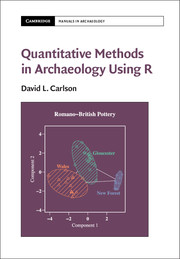Book contents
- Frontmatter
- Contents
- List of Figures
- List of Tables
- List of Boxes
- Acknowledgments
- 1 Introduction
- PART I R AND BASIC STATISTICS
- PART II MULTIVARIATE METHODS
- 10 Multiple Regression and Generalized Linear Models
- 11 MANOVA and Discriminant Analysis
- 12 Principal Components Analysis
- 13 Correspondence Analysis
- 14 Distances and Scaling
- 15 Cluster Analysis
- PART III ARCHAEOLOGICAL APPROACHES TO DATA
- References
- Index
13 - Correspondence Analysis
from PART II - MULTIVARIATE METHODS
Published online by Cambridge University Press: 22 July 2017
- Frontmatter
- Contents
- List of Figures
- List of Tables
- List of Boxes
- Acknowledgments
- 1 Introduction
- PART I R AND BASIC STATISTICS
- PART II MULTIVARIATE METHODS
- 10 Multiple Regression and Generalized Linear Models
- 11 MANOVA and Discriminant Analysis
- 12 Principal Components Analysis
- 13 Correspondence Analysis
- 14 Distances and Scaling
- 15 Cluster Analysis
- PART III ARCHAEOLOGICAL APPROACHES TO DATA
- References
- Index
Summary
Correspondence analysis provides a way to summarize categorical data in a reduced number of dimensions (Clausen, 1998; Greenacre, 2007). In that sense, it is very similar to principal components analysis. Principal components is an asymmetrical analysis. We use the correlations (or covariances) between the variables as a summary of the structure in the data. The principal components represent a way of describing the correlation matrix in fewer components than variables. The analysis is asymmetrical because we focus on the relationships between variables and use the principal components to compute scores for each of the observations in the new, reduced space.
In correspondence analysis, the data usually consist of counts of different kinds of things. They could be different artifact types from a variety of sites, strata, or features or they could be different elements in the composition of artifacts. Correspondence analysis is a symmetrical analysis because we adjust the data matrix by both the rows (observations) and the columns (variables) before conducting the analysis. As a result, we can project the observations into the space defined by the variables (as with principal components) or the variables into the space defined by the observations. We can also create biplots summarizing both views.
The adjustment of the data matrix is simply a modification of the Chi-square test that we covered in Chapter 9. In the Chi-square test we compute an expected value for a particular cell by multiplying the row sum by the column sum and dividing by the total sum. The difference between the observed and expected values is squared and divided by the expected value to get the Chi-square contribution for that cell. The sum of all the Chi-square contributions is the total Chi-square value that we use to see if the observed counts are significantly different from what we would expect by chance.
To perform a correspondence analysis, we modify that procedure slightly. First, we divide every value in the table by the sum of all the entries so that each cell represents the proportion of the total found in that cell. Then we compute the expected proportions using the row and column sums of the table of proportions.
Information
- Type
- Chapter
- Information
- Quantitative Methods in Archaeology Using R , pp. 279 - 295Publisher: Cambridge University PressPrint publication year: 2017
Accessibility standard: Unknown
Why this information is here
This section outlines the accessibility features of this content - including support for screen readers, full keyboard navigation and high-contrast display options. This may not be relevant for you.Accessibility Information
- 1
- Cited by
